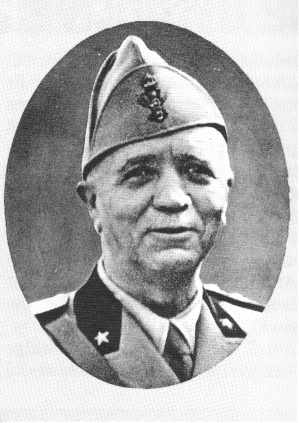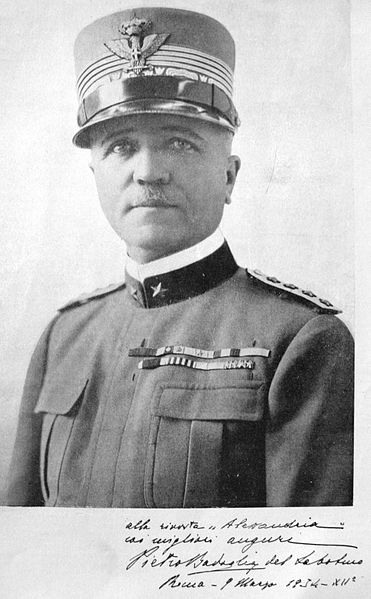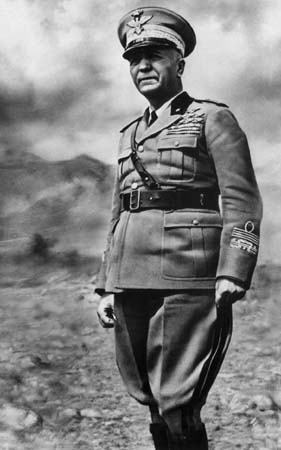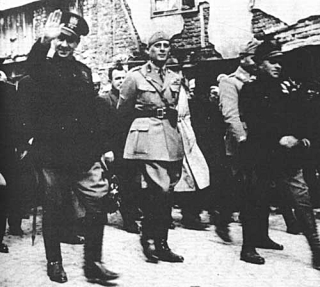<Back to Index>
- Maresciallo d' Italia and Prime Minister of Italy Pietro Badoglio, 1871
- Governor of Albania Francesco Jacomoni di San Savino, 1893
PAGE SPONSOR



Pietro Badoglio, 1st Duke of Addis Abeba, 1st Marquess of Sabotino (28 September 1871 – 1 November 1956) was an Italian soldier and politician. He was a member of the National Fascist Party and commanded fascist troops under Italian dictator Benito Mussolini in the Second Italo - Abyssinian War and is an alleged war criminal for the use of poison gas and systematically bombarding and strafing Red Cross hospitals and ambulances during the Ethiopia campaign. Due to post war expediencies, however, he was never brought to justice.
On 24 July 1943, as Italy had suffered several setbacks in World War II, Mussolini summoned the Fascist Grand Council, which voted no confidence in Mussolini. The following day Il Duce was removed from government by King Victor Emmanuel III and arrested. Badoglio was named Prime Minister of Italy and while mass confusion in Italy reigned, he eventually signed an armistice with the Allies. When this was made public, it threw Italy into chaos. A civil war took place, and the fascists fought the partisans. The king and Badoglio fled Rome leaving the Italian Army with no orders to follow.
Eventually from Brindisi on 13 October, Badoglio and the Kingdom of Italy declared war against Nazi Germany. Badoglio did not stay as Prime Minister for long however, as world opinion at that stage desired a person with a non - Fascist past to head the government. In June 1944, Badoglio was replaced by Ivanoe Bonomi of the Labor Democratic Party.
He was born in Grazzano Monferrato (later Grazzano Badoglio) in the province of Asti (Piedmont).
After studying at the military academy in Turin, he served with the Italian Army from 1892, at first as a Lieutenant (Tenente) in artillery, taking part in the campaigns in Eritrea (1896) and Libya (1912), where he distinguished himself at the Battle of Zanzur.
At the beginning of Italian participation in World War I, he was a Lieutenant Colonel (Tenente Colonnello); he rose to the rank of General following his handling of the capture of Monte Sabotino in May 1916 and by the late months of 1917 (mostly thanks to his Masonic contacts, including his superior, General Capello) was named as Vice Chief - of - Staff (Sottocapo di Stato Maggiore) despite being one of the main leaders responsible for the disaster during the Battle of Caporetto on 24 October 1917. With regard to the Battle of Caporetto, although he was blamed in various quarters for his disposition of the forces under his command before the battle, a commission of inquiry rejected most of the criticisms made upon him.
In the years after World War I, in which he held several high ranks in the Italian Army, Badoglio exerted a constant effort in modifying official documents in order to hide his role in the defeat.
Post war, Badoglio was named as a Senator, but also remained in the army with special assignments to Romania and the U.S. in 1920 and 1921. At first, he opposed Benito Mussolini and after 1922 was sidelined as ambassador to Brazil. A change of political heart soon returned him to Italy and a senior role in the army as Chief of Staff from 4 May 1924. On 25 June 1926, Badoglio was promoted to the rank of Marshal of Italy (Maresciallo d'Italia).
Badoglio was the first unique governor of Tripolitania and Cyrenaica (Italian Libya) from 1929 to 1933. During his goverorship, he played a vital part (with Rodolfo Graziani, deputy governor of Cyrenaica) in defeating the Libyan rebels. On 24 January 1932, Badoglio proclaimed the end of Libyan resistance for the first time since the Italian invasion in 1911.
Badoglio was not in East Africa when Emilio de Bono began the invasion of Abyssinia on 3 October 1935. De Bono was the Commander - in - Chief of all Italian military forces invading Ethiopia and he was in direct command of the invasion army on the northern front. Ultimately, the progress of De Bono's invasion was judged to be too slow by Mussolini. As a result, Badoglio, who in the meantime had launched an epistolary campaign against De Bono, replaced the latter in December. After the 26 December torture and murder of downed Italian pilot Tito Minniti, Badoglio asked for and was given permission to use chemical warfare.
Badoglio was immediately faced with the Ethiopian "Christmas Offensive" and he sought and received approval for the use of mustard gas. He employed it to effectively destroy the Ethiopian armies confronting him on the northern front. Badoglio commanded the Italian invasion army at the First Battle of Tembien, the Battle of Amba Aradam, the Second Battle of Tembien, and the Battle of Shire. On 31 March, Badoglio defeated Emperor Haile Selassie commanding the last Ethiopian army on the northern front at the Battle of Maychew. On 26 April, with no Ethiopian resistance left between his forces and Addis Ababa, Badoglio launched his "March of the Iron Will" to take the Ethiopian capital city and end the war. By 2 May, Haile Selassie had fled the country.
On 5 May 1936, Marshal Badoglio led the victorious Italian troops into Addis Ababa. Mussolini declared King Victor Emmanuel to be the Emperor of Ethiopia, and Ethiopia became part of the Italian Empire. On this occasion, Badoglio was appointed the first Viceroy and Governor General of Ethiopia and ennobled with the victory title of Duke of Addis Abeba.
On 11 June 1936, Rodolfo Graziani replaced Badoglio as Viceroy and Governor General of Ethiopia. Badoglio returned to his duties as the Supreme Chief of the Italian General Staff. According to Time magazine, Badoglio even joined the Fascist Party in early June.
Badoglio was not in favor of the Italian - German Pact of Steel and was pessimistic about the chances of Italian success in any European war but he did not oppose the decision of Mussolini and the King to declare war on France and Great Britain. Following the Italian army's poor performance in the invasion of Greece in December 1940, he resigned from the General Staff. Badoglio was replaced by Ugo Cavallero.
On 24 July 1943, following the Allied invasion of Sicily, there was a meeting of the Fascist Grand Council. On the following day, King Victor Emmanuel dismissed Mussolini as Prime Minister and appointed Badoglio to head the government in his place. Martial law was declared, Mussolini was arrested, and negotiations were covertly opened with the Allies. Publicly, the King and Badoglio claimed that Italy would remain with the Axis. Instead, they were plotting in the background.
On 3 September, General Giuseppe Castellano signed the Italian armistice with the Allies in Cassibile on behalf of Badoglio. On 8 September the armistice document was published by the Allies in the Badoglio Proclamation. It was published before Badoglio could communicate news of the switch to the Italian armed forces. The units of the Royal Army, Royal Navy and Royal Air Force were generally surprised by the switch and unprepared for German actions to disarm them. In the early hours of 9 September, Badoglio, King Victor Emmanuel, some military ministries and the Chief of the General Staff escaped to Pescara and Brindisi seeking Allied protection.
On 23 September, the longer version of the armistice was signed in Malta. The Badoglio government officially declared war on Germany on 13 October. Badoglio continued to head the government for another nine months. Following the German rescue of Mussolini, the liberation of Rome, and increasingly strong opposition, he was replaced on 9 June 1944 by Ivanoe Bonomi and other committed anti - Fascists. Badoglio was never tried for war crimes by the Allies primarily because he helped them during the invasion of Italy.

Francesco Jacomoni di San Savino (31 August 1893 – 17 February 1973) was an Italian diplomat and governor of Albania before and during World War II.
He was born in Reggio di Calabria on 31 August 1893 to a banker's family. In 1914 he enlisted in the army for his national service. Named Lieutenant of Fortress Artillery in June 1915, Jacomoni participated in the campaigns of the Italian Front of World War I. At the same time, he pursued his studies in Law at the University of Rome, and graduated in July 1916.
In May 1919 he was appointed as a member of the Italian delegation to the Paris Peace Conference, and worked as a liaison with the Austrian, Hungarian and later Bulgarian delegations. In October 1919 he was appointed as secretary in the Italian embassy at Bucharest, a post he held until recalled to the Ministry of Foreign Affairs in August 1920. In the next few years he served in various diplomatic missions and delegations as a secretary, including a brief mission to Albania in April 1926, where he laid much groundwork for the Italo - Albanian Friendship and Mutual Assistance Treaty of November 1926.
On his return, he became a close associate of Dino Grandi, then Undersecretary of Foreign Affairs and soon to become Minister. Initially head of the Ministry's Historical Service but later rising to be deputy head of Grandi's ministerial office, he participated in a number of missions to the Italian delegations to international conferences regarding the Dawes and Young plans, or the Second London Naval Conference.
In October 1932, Jacomoni married Maja Cavallero, the daughter of General (and later Marshal) Ugo Cavallero. During the next few years, he was engaged mainly in Geneva at the League of Nations. He was appointed as minister to the Kingdom of Albania from 9 September 1936 until shortly after the Italian invasion of Albania in April 1939. On 17 April he was promoted to ambassadorial rank and on 22 April he became the country's Viceroy (Luogotenente del Re, "Lieutenant - General of the King"). Jacomoni retained this post, which made him the country's effective governor, during much of the Italian occupation.
He was replaced with General Alberto Pariani on 18 March 1943, after his policy of severe repression had failed to halt the growth of the Albanian Resistance movement.
After the war, he was tried along with other senior officials of the Fascist regime, and sentenced by the Italian High Court to 24 years imprisonment on 12 March 1945. He was however released with the general amnesty issued by the Italian government in June 1946, and his sentence was finally commuted altogether in March 1948.
He published his memoirs on his tenure in Albania under the title of La politica dell'Italia in Albania in 1965, and died at Rome on 17 February 1973.